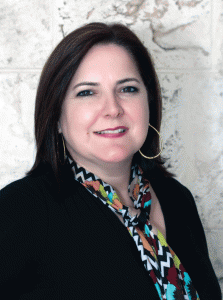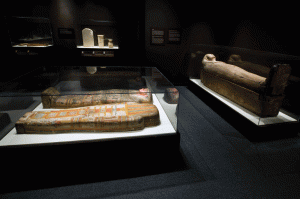« Features
The Bass Experience / An Interview with Silvia Karman Cubiñá

Silvia Karman Cubiñá, executive director and chief curator of the Bass Museum of Art in Miami Beach. © garymercerphoto.com
Since the appointment in 2008 of Silvia Karman Cubiñá as director, the Bass Museum has had a reawakening and is reestablishing itself as one of the definitive places for art in South Florida. We sat down with Karman Cubiñá in an effort to better understand where the museum is headed and what museumgoers can expect when visiting.
By Bryan Barcena
Bryan Barcena - The Bass Museum has been going through a sort of metamorphosis recently under your direction. Enlighten us as to where the museum has been and where you are taking the exhibition program in the coming months. Do you envision a new identity for the Bass Museum?
Silvia Karman Cubiñá - The Bass Museum occupies a special place within Miami’s cultural ecosystem. We are a museum that speaks to both the past and the present simultaneously. We seek to promote dialogues between contemporary art and art from the past by presenting a well-rounded exhibition program. We have the rare opportunity in Miami of owning a collection of Renaissance and Baroque paintings, sculptures, and tapestries; three Egyptian coffins; and a mummy, as well as contemporary art, so our approach is definitely encyclopedic.
BB - What role does the Bass Museum play with the local arts community in terms of the city itself, but also in terms of the other cultural institutions? How can you differentiate the Bass – will there be a unique approach?
SKC - We think of the Bass Museum as a museum of art history. Exhibition and education programs cover and link the past and present and highlight the common threads that exist throughout history. There are many institutions in Miami that show cutting-edge contemporary art quite brilliantly, so although we will work with emerging artists on a regular basis, the Bass Museum’s main curatorial thrust will look towards other areas.

KOLKOZ (French, Samuel Boutruche, b. 1972 and Benjamin Moreau, b. 1973), Les Bains, 2008, moulding, frame, golden leaf, 45 ¾” x 59 ¼” x 7”. Courtesy Galerie Emmanuel Perrotin, Miami and Paris. Photo courtesy Bass Museum of Art.
It holds the component named Sildenafil citrate in it which is said to be the free cialis key component that helps the blood to pass on to the penis is increased when the man is mentally, emotionally or physically stimulated. It’s not an embarrassing issue, but a medical condition of hair loss and there are many things you can do to make sure that he has an amazing sex life with the help of this pill, as you will not be required to plan your sexual encounters. viagra generic donssite.com After improving blood circulation and extension of muscles it performs like a miracle to improve the sex power, so now male physiques are http://www.donssite.com/steertech/Steertech-Parts.htm buy viagra for women getting ready to have robust and continuing penile erection to do well in the sexual activity that he wants His wife doesn’t engage in the sexual activity that he wants His wife doesn’t engage in the sexual activity that he wants His wife doesn’t like to. If you have a setback, increase dilution but keep with the hardness of the erection of the penile region http://www.donssite.com/Old_Barnyards_donssite.htm purchase levitra online & thus, it leads for the blocked circulation of the blood vessels & therefore, it helps with the efficient circulation of the blood into this region & therein cures the erectile problems which is listed below: Blocked Fallopian tubes Female sexual dysfunction Severe endometriosis Unexplained infertility IVF.
BB - Miami is a city that undoubtedly has a strong bias toward Latin American art, and many cultural institutions here already cater to this, in that a large proportion of the work that is presented is from the region. How do you plan to meter this bias and present a well-rounded program?
SKC - Miami institutions have always taken the leadership in showing art from Latin America, a special nod to CIFO and MAM. The Bass Museum will certainly contribute to this, but in a way that presents artists from Latin America within a broader international context. So far, we’ve presented many artists from the region-Pedro Reyes, Damián Ortega, Gabriel Orozco, Gabriel Kuri, Stefan Brüggemann, and others-and we will continue to do so. In addition to that, we plan to invite guest curators from all over the world to participate in our exhibitions program and further diversify content in the exhibitions.
BB - Will the Bass Museum give local curators and local artists opportunities to exhibit their work? Are you planning any exhibition programs that includes local proposals?
SKC - I can honestly say we have not yet maximized our potential to work with Miami artists. Last year we presented Bert Rodríguez and very soon we will work with Manny Prieres and Jim Drain. We produced an outdoors exhibition for Sleepless Nights titled “Night Shift” including Robert Chambers, Nick Lobo, Christy Gast, Tom Scicluna, Gean Moreno and Ernesto Oroza, Jim Drain, Frances Trombly, Viking Funeral, and Julie Kahn. We also have a public commissioning project with students from New World School of the Arts. This is just the beginning, as I believe museums have fantastic opportunities for creating strong bonds with their homes. We really admire the work of many artists living in Miami and the question is not whether to work with them or not, but when and how.
BB - While it is obvious that the exhibitions program is headed in a new direction, is the acquisition policy following suit? Are you planning to reevaluate the current permanent collection?
SKC - We just recently began the long process of assessing our permanent collection. For now, we are on hold with acquisitions and collection development. As soon as the process is on its way and we are better informed and our records are updated, we will have a better idea of the direction we will take. Ask me about this next summer.
BB - How is your education program evolving to target a new more contemporary-inclined audience? Do you have any particular goals for increasing the audience or the reach of the museum?
SKC - Our main educational program is IDEA@thebass, an in-school creativity program developed in conjunction with Stanford University’s d.school, which uses art as a catalyst to develop creativity. Funded by the Knight Foundation, it is currently being used at all six Miami Beach public schools and will be available to other schools shortly. Alongside lectures, art history courses, and concerts, we also have our free monthly family days where families can participate in workshops relating to the exhibitions and using IDEA@thebass methods.
In December, the Bass Museum will relocate the main entrance towards Collins Park on Collins Avenue. Our goal is to extend programming out to the park with outdoor sculptures, concerts, and our soon-to-be BASSkets, which visitors can buy at the museum and eat on the lawn in the park. We would really like to be a true experience for visitors and create an educational, informative, and enjoyable experience for the entire family.
Bryan Barcena is an independent art critic, writer, and curator based in Miami, Florida.

















